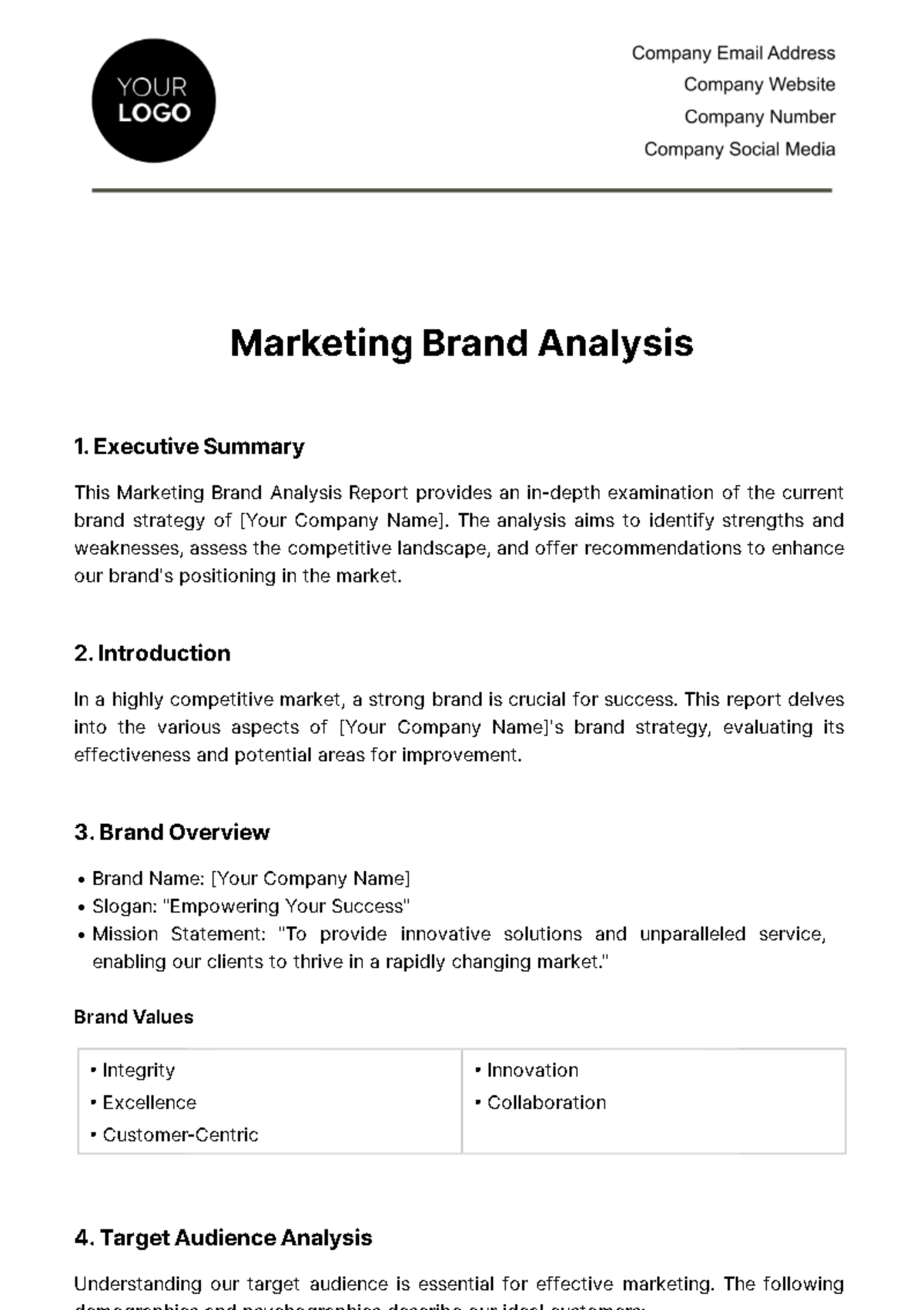Free Marketing Brand Analysis

1. Executive Summary
This Marketing Brand Analysis Report provides an in-depth examination of the current brand strategy of [Your Company Name]. The analysis aims to identify strengths and weaknesses, assess the competitive landscape, and offer recommendations to enhance our brand's positioning in the market.
2. Introduction
In a highly competitive market, a strong brand is crucial for success. This report delves into the various aspects of [Your Company Name]'s brand strategy, evaluating its effectiveness and potential areas for improvement.
3. Brand Overview
Brand Name: [Your Company Name]
Slogan: "Empowering Your Success"
Mission Statement: "To provide innovative solutions and unparalleled service, enabling our clients to thrive in a rapidly changing market."
Brand Values
|
|
4. Target Audience Analysis
Understanding our target audience is essential for effective marketing. The following demographics and psychographics describe our ideal customers:
Age: 25-45
Gender: Primarily male (60%) and female (40%)
Income Level: $40,000 - $80,000 annually
Interests: Technology enthusiasts, business professionals, entrepreneurs
Pain Points: Limited time for research, complex buying decisions, price sensitivity
5. Competitor Analysis
A thorough examination of our competitors provides insights into their branding strategies. Key competitors include:
Competitor 1 - Alpha Sales Solutions
Strong online presence
Innovative product offerings
High customer satisfaction
Competitor 2 - Beta Sales Innovators
Established industry leader
Diverse product range
Active in community outreach
Competitor 3 - Gamma Sales Co.
Aggressive pricing strategies
Expansive distribution network
Varied marketing channels
6. SWOT Analysis
Strengths | Weaknesses |
|
|
Opportunities | Threats |
|
|
7. Marketing Strategies
To enhance our brand's position, consider the following strategies:
Brand Differentiation: Emphasize our unique product features and exceptional customer service.
Content Marketing: Develop blog posts, videos, and infographics to educate customers about our solutions.
Social Media Engagement: Increase our presence on platforms such as LinkedIn, Twitter, and Instagram.
Partnerships: Explore collaborations with software providers to offer integrated solutions.
Customer Testimonials: Create a dedicated section on our website featuring success stories from satisfied customers.
8. Recommendations
Based on the analysis, we recommend the following actions:
Conduct a brand audit to ensure consistency across all touchpoints.
Implement a content marketing calendar to regularly publish valuable content.
Explore partnerships with software companies to expand our product offerings.
Monitor industry trends and adjust our branding strategy accordingly.
- 100% Customizable, free editor
- Access 1 Million+ Templates, photo’s & graphics
- Download or share as a template
- Click and replace photos, graphics, text, backgrounds
- Resize, crop, AI write & more
- Access advanced editor
Elevate your brand strategy with Template.net's Marketing Brand Analysis Template. This editable and customizable tool empowers you to delve into the intricacies of your brand's performance. Seamlessly adjust and refine using our Ai Editor Tool to tailor insights and strategies for maximum impact. Streamline your brand analysis process today!





























